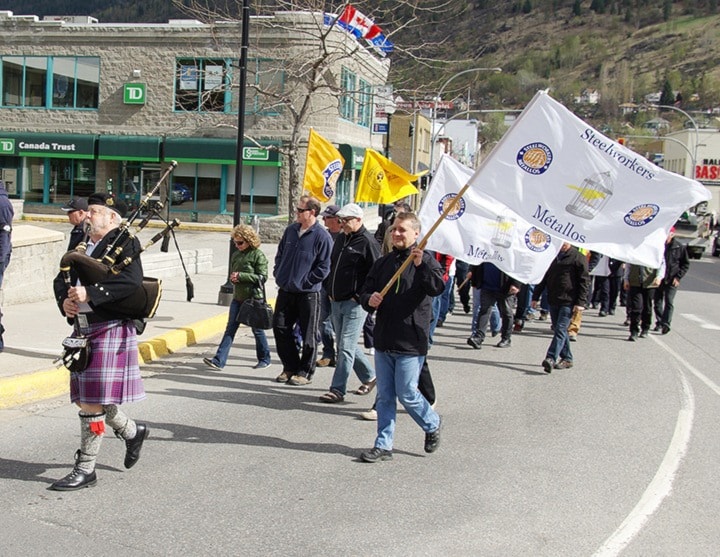Greater Trail residents took a moment Monday to pause and remember those who've lost their lives to work-related incidents or occupational diseases.
About 65 people gathered at the United Steelworkers Local 480 hall before taking part in a memorial march down Bay Avenue to the Day of Mourning Ceremony, held at the workers' memorial statue across from the arena.
“The message is the same as every year: It's just about taking that one day to sit and reflect, to reflect not only on people who have been killed on the job but also those who continue to suffer as a result of injuries,” said Gord Menelaws, health and safety chair for Local 480.
The day of reflection has occurred across the country for the past 30 years, with Trail taking part about half that time.
Menelaws is often reminded of Lonnie Plasko, who died while trying to halt an out of control train in 2007, or the many Local 480 and 9705 members (production, maintenance, office and technical workers) who suffered from asbestos-related diseases with limited help.
“The standards have changed and we do a lot more work on asbestos awareness and removal but it remains the same that people who get that disease sometimes don't get it until later on in life but they're cut off in their WorkSafe benefits at the age of 65,” he explained.
The government changed the legislation in 2002 so anyone over the age of 65 who got sick would not receive disability pay. There had previously been no age limit in place.
But an asbestos-related sickness can take up to 40 years before becoming detectable. On average, this means most people become ill well into their late 60s and early 70s. The local has pushed for a legislation change, which would acknowledge former workers who now suffer from asbestos cancers or their mourning families, through various efforts which included creating a documentary titled “Asbestos: the Silent Killer” that examines the human costs of industrial diseases and calls for reinstatement of disability pensions.
Since 1970, nine workers have lost their lives on Teck property, according to Menelaws.
“I'd say we've made some good improvements in some areas but like I say to people 'Even one injury is too many — one loss time accident is too many,'” he said.
“We strive for a zero goal and whether we ever get there or not I'm not sure, but that has to be the goal.”
WorkSafeBC notes that 128 workers died in B.C. last year, 21 fewer than the year before. Across the country 1,000 Canadians on average died, which works out to about three per day.
The march led by bagpiper Gordon Titsworth was followed by the ceremony's song of remembrance by vocalist Tracy Johnston, a moment of silence and speeches by key speakers which included Shawn Mitton, WorkSafe regional manager, and 9705 president Chuck Macklon on behalf of MLA Katrine Conroy. The mic was then opened up to the public to share their stories or memories of lost loved ones.
“A lot of surviving family members come to this ceremony and it means a lot for them to take part in the march and also to see the support that they have around their community for their loved ones that died.”
